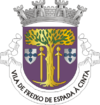Freixo de Espada à Cinta
| Freixo de Espada à Cinta | |||
|---|---|---|---|
| Municipality | |||
|
|||
 |
|||
| Coordinates: 41°5′28″N 6°48′28″W / 41.09111°N 6.80778°WCoordinates: 41°5′28″N 6°48′28″W / 41.09111°N 6.80778°W | |||
| Country |
|
||
| Region | Norte | ||
| Subregion | Douro | ||
| Intermunic. comm. | Douro | ||
| District | Bragança | ||
| Parishes | 4 | ||
| Government | |||
| • President | José Manuel Caldeira Santos (PS) | ||
| Area | |||
| • Total | 244.14 km2 (94.26 sq mi) | ||
| Population (2011) | |||
| • Total | 3,780 | ||
| • Density | 15/km2 (40/sq mi) | ||
| Time zone | WET/WEST (UTC+0/+1) | ||
| Postal code | 5180 | ||
| Area code | 279 | ||
| Website | http://www.cm-freixoespadacinta.pt/ | ||
Freixo de Espada à Cinta (Portuguese pronunciation: [ˈfɾɐjʃu dɨ (ɨ)ʃˈpada ˈsĩtɐ]), sometimes erroneusly Freixo de Espada Cinta (an archaism), is a municipality in the northeastern region of Portugal, near the border with Spain, along the Douro River Valley. The population in 2011 was 3,780, in an area of 244.14 km².
There have been historians that affirm that the Narbasi, a proto-Roman Iberian clan mentioned by Ptolemy, first gathered in this region.
There are various versions and legends associated with the municipalities toponymy. Of all the examples, there are common deductions: a Espada na Cinta de um Freixo (which literally means sword on the belt of an ash). There is no doubt that freixo in this context refers to the ash tree, a Portuguese derivative of the latin fraxinus, although the rest of the toponomic name is still confounded in legend. One legend recalls that the settlement of Freixo was established by a nobleman names Feijão, who died in 977, cousin of São Rosendo, whose heraldry included both an ash tree and belted-sword, to which the community received its name. Another legend suggests that the name was derived from a nobleman named Espadacinta; after a battle with Arabs along the margins of the Douro River, he arrived in this territory, and tired, he rested in the shadow of a large ash tree, where he hung his sword. This perpetuated the name for the settlement, which soon became known as Freixo de Espadacinta. A similar story recounts that it was King Denis who, fatigued from his battles with his illegitimate son (Afonso Sanches), and travelling through the wilderness of Freixo, he rested under the shadow of the ash tree, where he impaled his broadsword. The King fell asleep, and after a dream, declared that the village would be known as Freixo de Espada à Cinta. Today, near the Matriz Church, which once pertained to the medieval castle, exists an old ash tree, which is accepted by the local residents as the fabled tree impaled by the King.
...
Wikipedia


